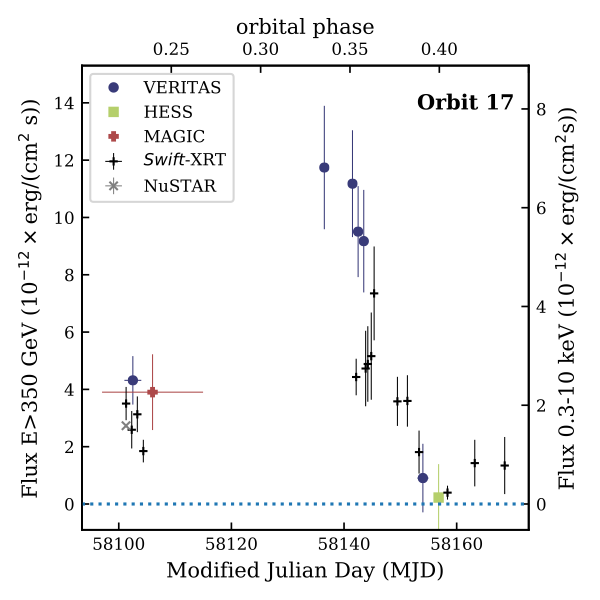
Reference: C.B. Adams et al. (The H.E.S.S., MAGIC, and VERITAS Collaborations), Astrophysical Journal 923, 241 (2021)
Full text version
ArXiv: ArXiV: 2109.11894
Contacts: Gernot Maier
A gamma-ray binary consists of a compact object, like a neutron star or a black hole, orbiting a massive star, with periodic release of large amounts of non-thermal emission at energies >1 MeV. There are only a few of these unusual objects known and new observations are key to better understanding how particles are accelerated to TeV energies in the environment of these objects.
The results of more than 15 years of observations of the gamma-ray binary HESS J063057 are presented in this publication. Data taken with the atmospheric Cherenkov telescopes H.E.S.S., MAGIC, and VERITAS at energies above 350 GeV were used together with observations at X-ray energies obtained with Swift -XRT, Chandra, XMM
-Newton, NuSTAR, and Suzaku. Some of these observations were accompanied by measurements of the Halpha emission line. This wealth of data allows for the first time to determine the dependency of the gamma-ray emission over the complete orbital phase, and discuss correlations of the emission at different wavelength in detail. A completely new result comes from the analysis of data of four orbital cycles with dense observational coverage. The VERITAS observations reveal short timescale variability, with flux-decay timescales of less than 20 days at very high energies. In addition, flux variations observed in the full data set obtained with all three instruments over the time scale of several years indicate orbit-to-orbit variability.
All data products can be downloaded from https://zenodo.org/record/5157848
FITS files: N/A
Selected figures from paper (click to get full size image):
(MJD0=54857.0; Bongiorno et al. (2011)). Vertical error bars indicate statistical uncertainties; note that these are smaller than the marker size for all X-ray instruments except for Swift-XRT. Fluxes are averaged over time intervals indicated by the horizontal lines (for most flux points these are smaller than the marker size).










